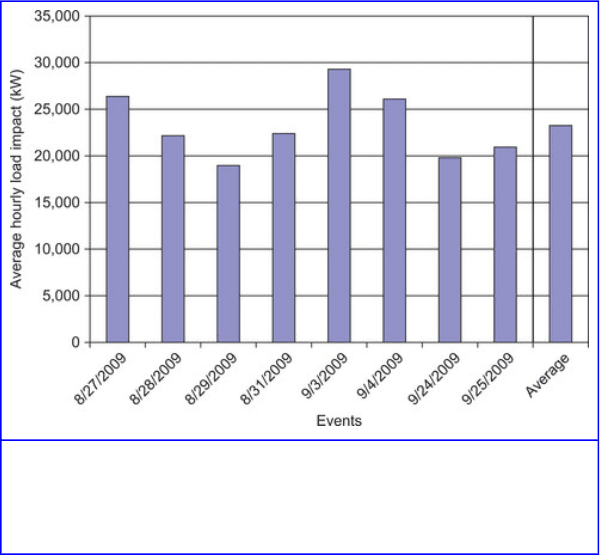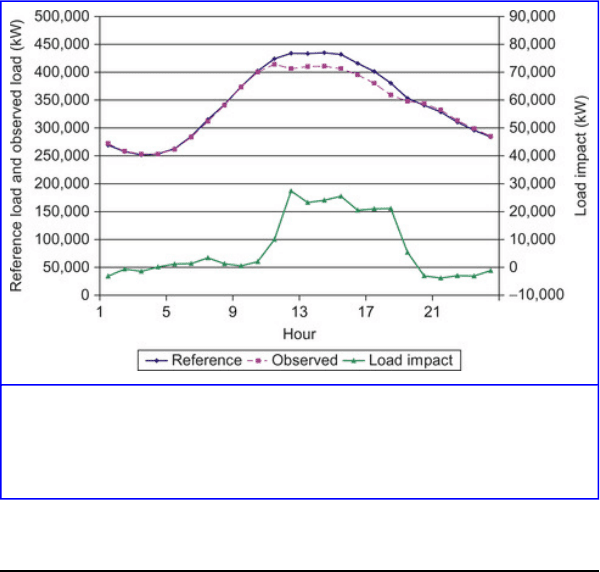Sioshansi F.P. Smart Grid: Integrating Renewable, Distributed & Efficient Energy
Подождите немного. Документ загружается.


Figure 12.6
Average event-hour CPP load impacts by event—SDG&E.
Source: Braithwait et al. [5]
Figure 12.7 illustrates the patterns of the estimated reference
load, observed load, and estimated load impacts (right axis)
for the average event day. Note that unlike the other utilities,
SDG&E's CPP prices apply to seven hours, beginning at 12
noon. Load impacts thus begin an hour earlier than at the
other two utilities. Similarly to PG&E, the reference load
takes on a typical commercial profile due to the large amount
of commercial customer (industry types 5 and 7) load, as
shown in Table 12.6.
611

Figure 12.7
Hourly load impacts for average CPP event day in 2009—SDG&E.
Source: Braithwait et al. [5]
Special Analyses of SDG&E Default CPP
While the voluntary CPP rates had previously required
customers to opt into, or choose to participate in the optional
rate (i.e., take action to enroll), SDG&E's default CPP tariff
provided the first case in which customers were enrolled via
an opt-out process. That is, eligible customers were
automatically enrolled in CPP and were required to take
action to leave the rate and return to the alternative TOU rate.
In addition, under default CPP, customers were given a
capacity reservation option, which allows customers to select
an amount of electric load (in kW) that they wish to protect
from the high CPP price during CPP events, and that they pay
for through a fixed monthly capacity reservation charge,
612

similar to a traditional demand charge. These two factors
provided us with an opportunity to examine two interesting
issues regarding default CPP:
1. Did the load response of customers previously enrolled
in SDG&E's voluntary CPP rate differ from that of newly
defaulted customers?
2. Does consumers' degree of load response appear to be
related to their level of capacity reservation?
We begin by characterizing the differences between the
customer accounts that previously volunteered for CPP and
those that were transitioned to default CPP beginning in 2008.
Table 12.7 and Table 12.8 illustrate the differences in the
average event-hour load impact, industry group makeup, and
price responsiveness of the two groups of customer accounts.
As shown in the last column, the overall percentage price
responsiveness of the previous CPP volunteers was twice that
of the newly defaulted customers (i.e., 10% compared to 5%).
However, the difference appears to be due largely to a change
in industry makeup, particularly a substantially lower share of
load (as shown in the column labeled “% of Max kW”) of
highly responsive customers in the Agriculture, Mining, and
Construction; and Wholesale, Transport, and Other Utilities
industry groups among the newly defaulted customers
compared to the previous volunteers.
Table 12.7
Characteristics of Customers Previously Enrolled in Voluntary CPP
Industry Type
Num.
of
SAIDs
Sum of
Max
kW
Sum of
Avg.
kWh
% of
Max
kW
Avg.
Size
(kW)
Avg.
Event
LI
%
LI
Source: Braithwait et al. [5].
613

1. Agriculture, Mining
& Construction
4 6,740 2,122 6% 1,685 980 43%
2. Manufacturing 28 8,495 4,723 7% 303 349 6%
3. Wholesale,
Transport, Other
Utilities
107 33,914 13,406 30% 317 3,196 24%
4. Retail stores 25 10,269 7,277 9% 411 163 2%
5. Offices, Hotels,
Health, Services
54 35,822 21,986 32% 663 1,591 6%
6. Schools 56 8,811 3,410 8% 157 0 0%
7. Government,
Entertainment, Other
Services
23 9,274 5,792 8% 403 596 9%
8. Other/Unclassified 0 0 0 n/a n/a 0
TOTAL 297 113,324 58,715 100% 382 6,875 10%
Source: Braithwait et al. [5].
Table 12.8
Characteristics of Customers Newly Defaulted to CPP
Industry Group
Num.
of
SAIDs
Sum of
Max
kW
Sum of
Avg.
kWh
% of
Max
kW
Avg.
Size
(kW)
Avg.
Event
LI
%
LI
1. Agriculture, Mining
& Construction
15 4,947 2,409 1% 330 95 4%
2. Manufacturing 194 84,202 43,487 17% 434 2,624 5%
3. Wholesale,
Transport, Other
Utilities
159 86,294 31,756 17% 543 3,216 10%
4. Retail stores 103 32,375 19,383 7% 314 1,982 7%
5. Offices, Hotels,
Health, Services
427 184,880 112,958 37% 433 6,346 5%
6. Schools 211 45,605 16,826 9% 216 0 0%
7. Government,
Entertainment, Other
Services
167 58,301 28,400 12% 349 2,156 6%
8. Other/Unclassified 7 857 570 0% 122 –35 –6%
Source: Braithwait et al. [5].
614

TOTAL 1,283 497,460 255,789 100% 388 16,384 5%
Source: Braithwait et al. [5].
The two groups of CPP customers also differed in their
decisions regarding capacity reservation level, which may
also have been related to their price responsiveness:
• The previous CPP volunteers accounted for 18.8% of the
default CPP customer accounts in 2009.
• Regarding the capacity reservation level (CRL), 41.5% of
all of the default CPP customer accounts kept the default
level of 50% (meaning half of their expected load was not
exposed to critical prices during event days).
• Of those service accounts that opted to change the
capacity reservation level, 81.7% selected a capacity
reservation level of zero.
• Customers' decision to change their CRL appears to be
related to prior participation in the voluntary CPP rate.
• 80.5% of prior voluntary CPP participants changed their
capacity reservation level (of which 83% selected zero).
• Only 53.3% of the newly defaulted CPP service accounts
changed their capacity reservation level.
Table 12.9 shows observed differences in percentage load
impacts by decisions regarding CRL. The 40% of customers
who kept the default CRL of 50% (first row) produced
average percent load impacts of 3%. In contrast, the nearly
60% of customers (second row) who changed CRL from the
default level of 50% (often to zero, as shown in the third row)
were three times as price responsive as those who kept the
default level (i.e., 9% load impacts compared to 3%).
615

Table 12.9
Differences in Percentage Load Impacts by Subgroups
Customer Type Percent of SAIDs Percent Load Impact
Kept default CRL (50%) 42% 3%
Changed from default CRL 58% 9%
Changed CRL to zero 48% 9%
Source: Braithwait et al. [5].
Concentrations of CPP Load Impacts
The methodology of estimating customer-specific regression
equations and load impacts also provides the capability to
examine the distributions of CPP load impacts across
individual customer accounts, and to determine the
concentration of load impacts among subsets of customers.
Table 12.10 summarizes some of the key indicators of the
concentration of CPP load impacts across the three utilities.
Table 12.10
Concentration of CPP Customer Price Responsiveness
Utility
Share of Customers with LI > 5
kW
Share of %Total LI from Top
5%
PG&E 40% 64%
SCE 59% 55%
SDG&E 35% 74%
Source: Braithwait et al. [5].
The first column in the table reports the percentage of
customers who were estimated to provide load impacts of at
least 5 kW. The 59% value for SCE (compared to 35 and 40%
for SDG&E and PG&E) is consistent with the findings of
greater price responsiveness among SCE's CPP customers.
16
The second column shows the share of load impacts provided
by the top 5% of CPP customers at each utility, where the
616

customers are ranked according to the size of their estimated
load impact. In general, the load impacts are distributed
similarly. Relatively large shares of load impacts are provided
by a relatively few customers. That is, the top 5% of the
customers provide 55–74% of the total program load impacts
across the three utilities. Concentration is greatest at SDG&E,
likely among the former volunteers, while load impacts are
least concentrated at SCE, again reflecting generally broad
price responsiveness.
16
Note that most of SCE's voluntary CPP customers selected the rate
option that has the highest CPP price (in return for a discounted summer
peak demand charge), and have historically included large and flexible
manufacturing and water utility customers who have the ability and
financial incentive to reduce load during CPP event hours.
Perspectives on CPP Participation and Load Impacts
In considering how applicable these CPP load impacts at the
major California utilities are to other utilities and regions,
certain key factors should be kept in mind. First, the results
are based on the actions of those customers who volunteered
for the program or, in the case of SDG&E's default tariff,
elected to stay on the tariff rather than opting out to a TOU
rate. The relatively small overall percentage load reductions
(e.g., 3–5% in 2010) and the concentration of load impacts
among a relatively small fraction of customers are reasonably
consistent with previous price-response findings regarding
RTP for large customers and CPP for residential customers.
17
The next few years will indicate how willing the defaulted
C&I customers at all of the utilities will be to remain on the
CPP tariff in the long term.
617
17
See Goldman et al. [8].
A second factor to keep in mind is that the same pool of
customers from which CPP participants are drawn have the
alternative option of participating in other demand response
programs and receiving financial payments for load
reductions on event days.
18
Thus, if a utility outside of
California were to offer CPP in the absence of alternative DR
programs, it would likely see a different rate of participation
and degree of price responsiveness. However, a number of
utilities operate in the footprint of organized wholesale
markets such as PJM, New York ISO, and ISO New England,
which operate a range of DR programs.
18
In most cases, consumers are not allowed to participate in both CPP and
a DR program, where events are likely to be called on the same days.
Exceptions are some emergency or reliability-based DR programs that
are expected to be called infrequently.
To illustrate how the CPP findings in California depend upon
the alternative DR programs, consider the following
enrollment and load impact information. In 2009,
approximately 2,600 customer accounts participated in CPP at
the three utilities. In 2010, enrollment grew to about 7,100
accounts with the transition to default CPP at PG&E and
SCE.
19
At the same time, aggregator-managed DR programs
in 2010 enrolled more than 5,000 customer accounts, and
SCE and PG&E enrolled 2,500 customer accounts in their
demand-bidding programs (DBP), all from the same pool of
large commercial and industrial customers from which CPP
draws. That is, approximately equal numbers of customers
participated in CPP and in DR programs in 2010.
19
618
See George et al. [9].
The estimated load impacts for the aggregator-managed and
demand-bidding programs in 2010 were 308 MW and 129
MW, respectively. In contrast, total CPP load impacts in 2009
and 2010 were 57 and 73 MW, respectively.
20
An emergency
program, the Base Interruptible Program (BIP), can provide
around 800 MW of load reduction during system
emergencies. With a total system maximum demand for the
three utilities of about 46 GW in 2009, the emergency load
relief from BIP amounts to nearly 2% of the system
maximum demand. The combined price-responsive load
impacts from CPP, DBP, and the aggregator-managed
programs amount to a little more than 1% of the system
maximum demand; CPP load impacts comprise a relatively
small portion of the total.
20
The 2010 load impacts are from George et al. [9].
As a final point of comparison, consider the following
differences in the price responsiveness of the CPP and DR
program customers, as measured by percentage load impacts.
As shown in Table 12.3, the CPP customers at PG&E, SCE,
and SDG&E in 2009 reduced load during CPP events by
3.3%, 18.9%, and 5.6%, respectively. In 2010, after PG&E
and SCE added several thousand newly defaulted customers,
the estimated percentage load impacts at PG&E and SDG&E
remained about the same, while those for SCE dropped to less
than 3%, as the strong price responsiveness of the core
volunteers in 2009 was diluted by less responsive newly
defaulted customers.
In contrast to those relatively small percentage load impacts
for CPP customers, the comparable values for the
619

aggregator-managed programs were much higher, ranging
from 20 to 30%.
21
There are two likely reasons for the larger
relative load impacts for the DR programs compared to CPP.
First, customers receive a combination of capacity credits for
promised load reductions, regardless of whether events are
called, and of energy payments for measured load reductions
during events. The capacity credits likely attract customers
who are willing to commit to reduce load, while penalty
provisions for not meeting commitments, as well as energy
payments for load reductions, provide strong incentives to
perform during events. Second, the third-party aggregators
have an incentive to work with enrolled customers to ensure
that in aggregate they produce the contractual load reductions
agreed upon with the utilities. Our understanding is that in
some cases aggregators assist customers with equipment or
procedures to automate load reductions when events are
called. To the extent that participants in the aggregator
programs are inherently more price responsive than
non-participants, then that portion of the population is
removed from the remaining population from which CPP
draws, thus leaving generally less responsive customers to
participate in CPP.
21
Percentage load impacts for most DBP customers were in the range of
those for CPP (see Braithwait et al. [6]).
Looking Forward
CPP in California
As noted above, enrollment of large C&I customers in CPP in
California increased substantially in 2010, as the utilities
transitioned to default CPP rates. Specifically, SCE moved
620
